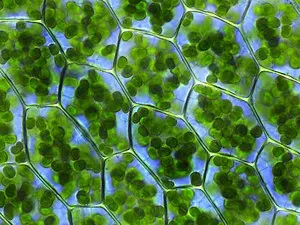Color represents the characteristic of electromagnetic radiation falling within the range of 300 to 400 and 700 to 800 nanometers. The specific color of individual chemical substances arises from how they interact with white light.
Biochromes play essential roles in diverse biological functions, such as providing tissue coloration, assisting in light absorption for plant photosynthesis, supporting animal vision, and acting as indicators for various physiological processes within organisms.
Here, we're going to learn about different biological pigments found in plants for Kerala PSC exams.
Types of Biological Pigments
Biological Pigments Found in Plants
Biological pigments serve numerous crucial functions in plants, playing pivotal roles in photosynthesis, protection against environmental stressors, the attraction of pollinators, and signaling developmental stages.
1. Chlorophyll:
These are the primary pigments responsible for capturing light energy during photosynthesis. They absorb light primarily in the blue and red wavelengths while reflecting green light, which gives plants their characteristic green color.
They are responsible for the green coloring of the plant leaves and parts of the stem in a plant body.
The name chlorophyll is derived from two Greek words, Chloros which means green, and phyllon meaning leaf.
Chlorophyll molecules are located within organelles known as chloroplasts (grana of the chloroplast), where they convert light energy into chemical energy, producing sugars essential for plant growth and development.
There are two types of chlorophylls in green plants. These are chlorophyll a and chlorophyll b. They are considered as the primary photosynthesis pigments.
Chlorophyll a produces dark green colours and chlorophyll b produces yellowish green colours. Plants have more chlorophyll a than b.
Chlorophyll a is mainly found in algae, cyanobacteria, and all higher plants whereas chlorophyll b is found only in green algae and higher plants.
Chlorophyll was first isolated and named by two French men, Joseph Bienaimé Caventou and Pierre Joseph Pelletier in 1817.
The identification of magnesium in chlorophyll occurred in 1906, marking the initial recognition of this element within living tissue.
2. Carotenoids:
These pigments are responsible for the yellow, orange, and red hues seen in various plant parts, including fruits, flowers, and leaves.
They are found in the chloroplasts and chromoplasts of the plants.
Carotenoids serve as accessory pigments in photosynthesis, absorbing light in different wavelengths than chlorophyll. They also act as antioxidants, protecting plant cells from damage caused by excessive light and free radicals.
They are water-insoluble and found in the membranes of the cell body. As they are great sources of antioxidants, they promote eye health in humans.
There are two main types of carotenoids.
- Carotenes
- Xanthophylls
Carotenes include pigments like 𝛃-carotene (beta-carotene) and lycopene where as Xanthophylls include pigments like lutein and zeaxanthin. 𝛃-carotene is also known as Provitamin A.
3. Flavonoids:
Flavones, flavonols, flavanones, etc.: Flavonoids comprise a diverse group of pigments (over 5000 naturally occurring flavonoids) found in plants, contributing to colors ranging from yellow to red.
The word Flavonoid is derived from the Latin term flavus meaning yellow.
Beyond their role in pigmentation, flavonoids have antioxidant properties, assist in UV protection, and play roles in defense against pathogens.
4. Anthocyanins:
A type of Flavonoid is responsible for vibrant red, purple, and blue colors (based on the pH value) in many flowers, fruits, and leaves, anthocyanins are water-soluble pigments.
Anthocyanin is derived from two Greek words: Anthos meaning flower and Kyanos meaning blue.
They not only attract pollinators but also act as a defense mechanism against UV radiation and herbivores. Additionally, their color intensity can change based on pH levels, serving as indicators of soil acidity.
There are additional biological pigments such as Tannins, Betalains, Quinones, and Xanthones. But we're only using general classification here based on the pattern found in the Kerala PSC Question papers.
Biological Pigments Found in Animals
In the animal world, biochromes often serve as a defense mechanism such as to provide camouflage so that they can blend in the background, signaling, breeding conditions, etc.
Major biological pigments found in animals are as follows:
Melanin
They are the main pigment found in mammals. Melanin is responsible for the hair color and fur color.
They produce colors ranging from black to red eg; the Coloring of the mane of the lion.
Keratin
It is a structural protein mainly found in hair, nails, horns, hooves, feathers, etc. They play a major role in cellular activities such as cell growth and protein synthesis.
Luciferin
Some of the organisms such as fireflies and bacteria exhibit a light-emitting phenomenon called bioluminescence with the help of a biological substance called luciferin.
Carotene
They are found in the chromoplasts of the animals.
Different Biological Pigments Found in Animals, Plants & Fruits
The following table is very important for Kerala PSC as many of these items are repeatedly asked in the PSC Question papers:
Animals / Plants / Fruits Biological Pigments Apples Flavonols Green Apples Chlorophyll Beetroot Betacyanin Bile Bilirubin, Biliverdin Blood Haemoglobin Blackberries Anthocyanin Blueberries Anthocyanin Brinjal Anthocyanin Broccoli Chlorophyll Carrots Carotene Egg Yolk Xanthophyll Grapes Anthocyanin, Polyphenol Guava Lycopene Hair Melanin Meat / Muscles Myoglobin Milk Casein (White, Riboflavin)
Carotene (Yellow) Onions Flavonols Oranges Flavonones
(Hesperidin & Naringenin) Papaya
(Red Fleshed) Lycopene Purple Potatoes Anthocyanin Red Spinach
(ചീര) Anthocyanin Red Cabbage /
Violet Cabbage Anthocyanin Saffron Bixin Skin Melanin Tomatoes Lycopene Turmeric Curcumin Urine Urochrome Watermelon
(Red Fleshed)
Lycopene
| Animals / Plants / Fruits | Biological Pigments |
|---|---|
| Apples | Flavonols |
| Green Apples | Chlorophyll |
| Beetroot | Betacyanin |
| Bile | Bilirubin, Biliverdin |
| Blood | Haemoglobin |
| Blackberries | Anthocyanin |
| Blueberries | Anthocyanin |
| Brinjal | Anthocyanin |
| Broccoli | Chlorophyll |
| Carrots | Carotene |
| Egg Yolk | Xanthophyll |
| Grapes | Anthocyanin, Polyphenol |
| Guava | Lycopene |
| Hair | Melanin |
| Meat / Muscles | Myoglobin |
| Milk | Casein (White, Riboflavin) Carotene (Yellow) |
| Onions | Flavonols |
| Oranges | Flavonones (Hesperidin & Naringenin) |
| Papaya (Red Fleshed) | Lycopene |
| Purple Potatoes | Anthocyanin |
| Red Spinach (ചീര) | Anthocyanin |
| Red Cabbage / Violet Cabbage | Anthocyanin |
| Saffron | Bixin |
| Skin | Melanin |
| Tomatoes | Lycopene |
| Turmeric | Curcumin |
| Urine | Urochrome |
| Watermelon (Red Fleshed) | Lycopene |
Diseases caused by the lack of Biological Pigments
There are four main diseases identified by the lack of pigmentation. They are
- Albinism: caused due to the partial loss of melanin, hereditary.
- Leucism: partial loss of pigmentation in animals.
- Melasma: Dark brown patches appearing on the face.
- Lamellar Ichthyosis: rare genetic skin condition caused due to the excess production of melanin, fish scale disease.
📝SideNotes:
- Biological Pigments found in Grana of the plants - Chlorophyll a, Chlorophyll b, Carotene & Xanthophyll.










Post a Comment
Post a Comment